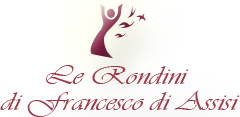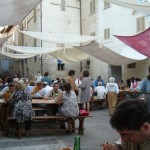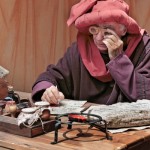The Market of the Gaites
A dive in the past, the medieval one, involving every year the town of Bevagna that awakens and lives in the ancient world. The Gaite Market is the most important and well-known Bevagna event, which takes place in the last decade of June.
From the Longobard Watha (guard) comes the denomination of guaita or gaita with which are indicated the four neighborhoods in which Bevagna was divided and the surrounding territory.
Their names derive from the 4 ancient churches: San Giovanni (the present S. Michele Arcangelo), Santa Maria Filiorum Comitis, San Pietro and San Giorgio, now SS. Domenico and Giacomo.
- Gaita San Giorgio
The gaita S.Giorgio extends between the main square and Porta S.Vincenzo, to the right of Via Flaminia, current Corso Matteotti.
Very large, but not very populous, it was occupied by three great convents: that of the Dominicans with the annexed church, the monastery S.Margherita and the one called “Monte”.
Noteworthy are archaeological finds, among which we indicate the remains of a Roman domus and perhaps a thermal building. The name S.Giorgio comes from an oratory donated by the Commune in 1291 to Blessed Giacomo, who built the beautiful church of S.Domenico.
The gaita boasts a group of young people, the “Novus Ignis”, with the passion for music and the deepening of the music of the 13th and 14th centuries. In addition, the Gaita has recently given birth to a choir, thanks to the help of the S.Margherita Monastery and a group of medieval dancers.
Among the various crafts made we remember iron, mint and violin making.
Ironwork requires tools such as anchoring, hammer and a forge powered by a boom operated by the shop boy. Unmistakable is the blacksmith’s hand that forges the incandescent iron to create precious objects or simple tools. The hammer that beat the life of the shop on the cynical rhythm and is warned far in the streets, becoming even a musical instrument in the many scenic animations.
- Gaita San Giovanni in Bevagna
Walking from the square to the ancient gate S.Vincenzo, to the left of the Flaminia – Decumanus of the Roman Mevania – meets the Gaita S.Giovanni, the largest and most populous of the city and rich of remarkable monuments of the Roman age. The denomination comes from the oratory of St. John the Baptist surrendered in 1275 to the Friars Minor of St. Francis, who built the homonymous church.
The gaita S.Giovanni aims to privilege moments of great spectacularity, with a rather sophisticated technique.
The central stage of paper processing is the smear reduction of rags, already smudged and macerated in the lime by means of the “multiple spin hydraulic pile”; This mash is then poured compactly into sheets that are spun, dried and finally treated with an animal binder.
The product, finished and selected, was marketed in reams at a qualified user. The complexity of the machining cycle required great efforts in the reconstruction of work equipment.
Equally demanding was the reproduction of glass processing. The raw material, fine white sand, or river cobblestones is combined with a source derived from the combustion of marine shrubs; The glass paste, thus obtained, is melted in special crucibles. Processing continues with the cooling of the molten material, which is drawn with the end of a hollow and rotated barrel in the air, so that the pasta is attached to it, then, blowing in the barrel, it shapes in the desired shape the object , Which is tempered in another chamber of the melting furnace.
- Gaita San Pietro in Bevagna
The Gaita S.Pietro is located, proceeding from the main square towards Porta S. Agostino, to the right of Via Flaminia, current Amendola course. This is the less extensive neighborhood of the city, so that in the 16th century, to overcome the difficulties encountered in finding the number of representatives to be sent to the General Council, it was decided to extend it to Porta Guelfa, ingoblando a sector of St. John .
It derives its name from the church of S.Pietro which no longer traces, but which stood near the convent of St. Augustine. Interesting are the churches of St. Augustine, founded in 1316 with the annexed convent, and that of St. Philip, built in 1720 by the Congregation of the Filipinos. The indications that came from the toponomastics have helped locate the baker’s main shop in the district: the area called “the furnaces” preserves, in addition to the name, also in its succession of arch doors, the memory of the old ovens overlooked. The gaita started from this figure to accomplish the first of its trades, which allowed the banquets to find those fragrances and those atmospheres which in fact were alive until a few decades ago.
On the main square of the gaita is also the shop of the speziale, which reproposes a beautiful medieval interior, accompanied by the laboratories of the distillery and the herbalist.
Also interesting is the wax processing workshop, where candles are produced according to the rules laid down by municipal statutes: starting with the preparation of hemp wicker to achieve the candle. This is achieved through successive castings of melted wax, candles for religious use or for subsequent diving in the candles for daily use. The candles thus obtained were rounded and smooth by immersion in lukewarm water and subsequent pressure between two wooden tablets.
- Gaita Santa Maria in Bevagna
In front of Gaita S.Pietro opens S.Maria, one of the most populous neighborhoods of the city. It is named after the church of S.Maria filiorum comitis, built by Count Rainaldo d’Antignano and known since 1198. The gaita is characterized by a well-preserved and well-preserved construction with houses of the ‘300 and’ 400 And beautiful private homes. With no special monuments, it preserves the Roman enclosure in travertine blocks of the I century. B.C. Also beautiful is the 15th century tower of Pt Molini, so called by the mills of grain and oil existed since the Middle Ages, activated by the waters of Clitunno.
In the choices related to the organization of the party, Gaita S.Maria preferred to stick with strict fidelity to the local historical and economic data: so in the craftsmanship, he started working with hemp to reach the production of canvases and resistant cordage. Cultivation of hemp, spread throughout the plain, was in fact one of the most important voices of the local economy; It was sold in the so-called canape forum, placed at the door of the supra superspeed, which I put on Sanctii Vincentii.
Exquisite were the canvases that were produced here to be whitewashed in the waters of Hecton. The hemp stems are so macerated to allow the fibers to be separated from the woody part, followed by tying and finally combing the fibers, which are so readily machined by skilled filaments. From large chassis, therefore, exquisite canvases emerge, which, in a very suggestive environment, are painted by young women. At the completion of the trade, wool processing was then carried out, followed at all stages, from being crushed and scraped to spinning.
The purpose of the event is to reconstruct the daily life of the inhabitants of Bevagna in the period between 1250 and 1350 with the greatest historical reality and richness of detail.
So during the period of the event, the old medieval craft shops reopen the doors and resume the activities and the city, involved in this splendor, recovers the traditions and historical roots,
The Gaite Market is the triumph of ancient crafts such as brickwork, cord making, wrought iron and wickerwork. The processing and production of hemp, the home-made tradition of bevelled china, pottery and blacksmith craft, wax, glass manufacturing and parchment paper production, the coin of coins.
Each year, each gay person faithfully recreates environments and medieval situations with careful and accurate reconstruction of shops, crafts and markets.
So you can find the market benches that sell the goods typical of the period: from cloth to iron, from candles to various foods
Each gaita also has its own medieval tavern where you can enjoy the typical dishes of medieval Umbria cuisine.
4 are the races that determine the winner: the market competition, the craft race, the gourmet race, the archery race.
Experts from the various fields called to judge above all the historical credibility, the last day of the event decree the winner of the stake.
PROGRAM
ALL SEASONS FROM FRIDAY 16 TO SUNDAY 25 JUNE 2017
• Taverns open from 8 pm (Saturday 17 and 24 / Sunday 18 and 25 open for lunch)
• Inns open from 19.00
FROM FRIDAY 16 TO SATURDAY 24 JUNE 2017: Shops of Medieval Crafts opened in the following days and times:
• from Friday 16 until Saturday 24 from 20:45 to 23:30;
• Every Saturday open from 17.00 to 19.00 and from 20.45 to 23.30;
• Sunday 18 from 10.30 to 13.00; From 17.00 to 19.00 and from 20.45 to 23.30
JUNE 15 JUNE
22.00 hours – Piazza F. Silvestri
AND HAVE FESTIVAL, SAY GREAT FESTIVAL, Opening Ceremony – Iuramentum potestatis and Artis Guaitarum in Procession
FRIDAY 16 JUNE
From 19.00 – Giullari, musicians and jugglers in streets and squares
• Ensemble Musicanti Potestatis
• Devil’s Jailers
• The Lilliput musicians
SATURDAY 17 JUNE
From 15.00 / Piazza F. Silvestri – Cancel Filatelico
Gaite’s arts on display
4 pm / Gaita San Giorgio – Zeccherius and Pictor
16.00 pm / Gaita San Giovanni – Ars chartaria and Ars biccherorum
From 19.00 – Giullari, musicians and jugglers in streets and squares
• Musicians Potestatis
• Devil’s Jailers
• Lilliput musicians • Finisterrae
• Manipura Fire
SUNDAY 18 JUNE
National Disfidation with Archery
From 9.00 am – Itinerary on the streets of the country
11.00 am / Church of San Michele – Missa De Angelis, laude and medieval hymns – Ensemble Vocale Liber Cantus (Director Vladimiro Vagnetti)
15.00 hrs / Piazza F. Silvestri – Archery Finals with archery
Gaite’s arts on display
Hours 16.00 / Gaita San Pietro – Scriptorium and Ars tinctoria
Hours 16.00 / Gaita Santa Maria – The Ars of the Ars tabernariorum, panicoculorum et albergatorum
From 19.00 – Giullari, musicians and jugglers in streets and squares
• Musicians Potestatis
• Finis Terrae
• Manipura Fire
At 22.30 / San Silvestro Church
Machillian Guillame de Notre Dame Mass Concert – Ensemble NOVA ALTA in collaboration with Ensemble VOX POETICA
MAY 19 JUNE
Artes Guaitarum – Gaita San Giovanni and San Giorgio in the race
From 19.00 – Giullari, musicians and jugglers in streets and squares
• Conjugation of the Giullari
• Manipura Fire
TUESDAY 20 JUNE
Artes Guaitarum – Gaita Santa Maria and St. Peter in the race
From 19.00 – Giullari, musicians and jugglers in streets and squares
• Conjugation of the Giullari
• Folet d’la Marga
WEDNESDAY JUNE 21
Coquina Guaitarum – Gaita San Giovanni and San Giorgio in the race
From 19.00 – Giullari, musicians and jugglers in streets and squares
• Acrobats of the Village
• Folet d’la Marga
NIGHT OF MEDIEVAL ROMANTIC MUSIC *
22.30 hrs / Logge of the Covered Market
Concert Amour, but douce dame: ars amateur and loving kind – Musicians Potestatis
JUNE 22 JUNE
Coquina Guaitarum – Gaita Santa Maria and St. Peter in the race
From 19.00 – Giullari, musicians and jugglers in streets and squares
• Musicians Potestatis
• Acrobats of the Village
• Vagantes clerics
FRIDAY 23 JUNE
From 19.00 – Giullari, musicians and jugglers in streets and squares
• The Devils Jolly
• Musicians Potestatis
• Vagantes clerics
22.30 hours / Church of St. Silvestro
Concert Amor makes me sing: dances, madrigals and ballads of the 300 Italian Ensemble Orientis Partibus of Assisi
SATURDAY 24 JUNE
From 4 pm – Gaite Markets on display
From 4 pm – Jewelers, musicians and jugglers in streets and squares
• Musicians Potestatis
• Saint Macinello Company
• Devil’s Jailers
• Minotaur kalofèn
Largo Gramsci / The military encampment of the 14th century
18.00 hrs / Logge of the Covered Market
The Gaite Marketplace meets the Middle Ages Festival
MEDIEVAL ROMANTIC NIGHT *
22.00 / Piazza Filippo Silvestri – Falconry Show
23.00 hrs / Church of San Silvestro
Concert Kiss kiss does not lose venture: echoes of love in the lyrics of Dolce Stil Novo – Ensemble CANTORIA MEVANIAE
SUNDAY 25 JUNE
Gaite Markets on display
• 10.30 am: Gaita San Giorgio
• 10.30 am: Gaita Santa Maria
• 16.30 hours: Gaita San Pietro
• 16.30 hours: Gaita San Giovanni
Mercatores Guaitarum in the race
• 10.30 am: Gaita San Pietro
• 11.30 am: Gaita San Giovanni
• 16.30 hours: Gaita San Giorgio
• 5.30 pm: Gaita Santa Maria
From 10.30 am – Jewelers, musicians and jugglers in streets and squares
• Musicians Potestatis
• Saint Macinello Company
• Devils jolly
• Minotaur Kalofen
16.30 / Piazza Filippo Silvestri – Falconry show
Largo Gramsci / The military encampment of the 14th century
22.30 hours / Piazza F. Silvestri
AND HAVE FESTIVAL, IS GREAT FESTIVAL
Closing Ceremony of Gaite Market 2017 with Tire Race with the historic arch
Proclamation of the Gaita winner and assignment of the Palio 2017
* Events in collaboration with the most beautiful villages in Italy
MARKET ASSOCIATION
More info and event booking: 0742 361847/335 597 7629 – info@mercatodellegaite.it
FROM 15 TO 25 JUNE 2017
THEATER FRANCESCO TORTI – LOOKS FROM MEDIUMY, photographic exhibition by Roberto Campanaro
COVERED MARK LOGGE – Exhibition of medieval musical instruments













